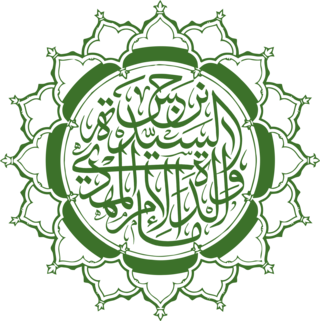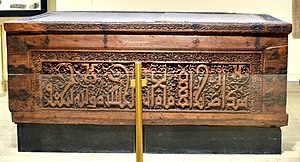The Fatimid dynasty was an Arab dynasty that ruled the Fatimid Caliphate, between 909 and 1171 CE. Descended from Fatima and Ali, and adhering to Isma'ili Shi'ism, they held the Isma'ili imamate, and were regarded as the rightful leaders of the Muslim community. The line of Nizari Isma'ili imams, represented today by the Aga Khans, claims descent from a branch of the Fatimids. The Alavi Bohras, predominantly based in Vadodara also claim descent from the Fatimids.
Ja'far ibn Muhammad al-Sadiq was a Shia Muslim scholar, jurist, and theologian, and the sixth imam of the Twelver and Isma'ili branches of Shia Islam. Known by the title al-Sadiq, Ja'far was the founder of the Ja'fari school of Islamic jurisprudence. The hadith recorded from al-Sadiq and his predecessor, Muhammad al-Baqir, are said to be more numerous than all the hadith preserved from the Islamic prophet Muhammad and the other Shia imams combined. Among other theological contributions, he elaborated the doctrine of nass and isma, as well as that of taqiya.
Isma'il ibn Ja'far al-Mubarak was the eldest son of Ja'far al-Sadiq and the sixth imam in Isma'ilism. He carried the epithet of al-Mubarak, on the basis of which one of the earliest Isma'ili groups became designated as the Mubarakiyya.

Ali ibn Musa al-Rida, also known as Abū al-Ḥasan al-Thānī, was a descendant of the Islamic prophet Muhammad, and the eighth imam in Twelver Shia Islam, succeeding his father, Musa al-Kazim. He is also part of the chain of mystical authority in Sunni Sufi orders. He was known for his piety and learning, and a number of works are attributed to him, including Al-Risala al-Dhahabia, Sahifa al-Rida, and Fiqh al-Rida. Uyun al-Akhbar al-Rida by Ibn Babawayh is a comprehensive collection that includes his religious debates and sayings, biographical details, and even the miracles which have occurred at his tomb. He is buried in Mashad, Iran, site of a large shrine.

Muhammad ibn Ali al-Jawad was a descendant of the Islamic prophet Muhammad and the ninth of the Twelve Imams, succeeding his father, Ali al-Rida. He is known by the epithets al-Jawād and al-Taqī. Like most of his predecessors, Muhammad kept aloof from politics and engaged in religious teaching, while organizing the affairs of the Imamite Shia community through a network of representatives. The extensive correspondence of al-Jawad with his followers on questions of Islamic law has been preserved in Shia sources and numerous pithy religio-ethical sayings are also attributed to him.

ʿAlī ibn Muḥammad al-Hādī was a descendant of the Islamic prophet Muhammad and the tenth Imam in Twelver Shia, succeeding his father, Muhammad al-Jawad. Born in Medina in 828, Ali is known with the titles al-Hādī and al-Naqī. After the death of his father in 835, most followers of al-Jawad readily accepted the imamate of Ali, who was still a child at the time. Drawing parallels with the story of young Jesus in the Quran, Twelver sources attribute an exceptional innate knowledge to Ali which qualified him for the imamate despite his young age.

Hasan ibn Ali ibn Muhammad, better known as Hasan al-Askari, was a descendant of the Islamic prophet Muhammad. He is regarded as the eleventh of the Twelve Imams, succeeding his father, Ali al-Hadi. Hasan Al-Askari was born in Medina in 844 and brought with his father to the garrison town of Samarra in 848, where the Abbasid caliphs held them under close surveillance until their deaths, even though neither were politically active. After the death of al-Hadi in 868, the majority of his following acknowledged his son, al-Askari, as their next Imam. Al-Askari's contact with the Shia population was restricted by the caliphs and instead he communicated with his followers through a network of representatives. He died in Samarra in 873-874 at the age of about twenty-eight and was buried in the family home next to his father, which later developed into al-Askari shrine, a major center for Shia pilgrimage. Shia sources commonly hold the Abbasids responsible for the death of al-Askari and his father. A well-known early Shia commentary of the Quran is attributed to al-Askari.

Muhammad ibn Hasan al-Mahdi is believed by the Twelver Shia to be the last of the Twelve Imams and the eschatological Mahdi, who will emerge in the end of time to establish peace and justice and redeem Islam.

The Alids are those who claim descent from Ali ibn Abi Talib, the fourth Rashidun caliph and the first imam in Shia Islam. Ali was also the cousin and son-in-law of the Islamic prophet Muhammad. The main branches are the Hasanids and Husaynids, named after Hasan and Husayn, the eldest sons of Ali from his marriage to Fatima, the daughter of Muhammad. As the progeny of Muhammad, they are revered by all Muslims. The Alids have led various movements in Islam, and a line of twelve Alids are the imams in Twelver Shia, the largest Shia branch.
Fatima bint Musa, circa 790–816 CE, commonly known as Fatima al-Ma'suma, was the daughter of Musa al-Kazim and sister of Ali al-Rida, the seventh and eighth Imams in Twelver Shia. A young Fatima left her hometown of Medina in about 816 to visit her brother al-Rida in Merv, but fell ill along the way and died in Qom, located in modern-day Iran. She is revered for her piety in Twelver Shia and her shrine in Qom is a major destination for pilgrimage.

Narjis is believed by the Twelvers to have been the mother of their Hidden Imam, Muhammad al-Mahdi. His birth is said to have been providentially concealed by his father, Hasan al-Askari, out of fear of Abbasid persecution as they sought to eliminate an expected child of the eleventh Imam, whom persistent rumors described as a savior. After the death of his father in 260 AH, al-Mahdi is believed by the Twelvers to have entered a state of occultation which continues until his rise in the end of time to establish peace and justice on earth. The origin of Narjis is recorded as the Byzantine or Nubia and her tomb is believed to be located in the al-Askari shrine in Samarra, Iraq.
Muhammad ibn Isma'il al-Maktum was the eldest son of Isma'il al-Mubarak and the seventh Imam in Isma'ili Shia Islam. When Isma'il died, his son Muhammad continued to live in Medina under the care of his grandfather Ja'far al-Sadiq until the latter's death in 148/765. After the death of Abd Allah al-Aftah, Muhammad was the senior most member of this Fatimid branch of al-Husayn's descendants. However, due to the rival group that recognized Musa al-Kazim and the Abbasid persecution of all Fatimids, Muhammad fled Medina with his sons for the east. For this reason, he was known as al-Maktum. He had two sons when living in Medina and then four more sons after his emigration, among whom was his successor Ahmad al-Wafi. Muhammad's descendants further founded the Fatimid dynasty, later called the Nizari and Musta'li.
The Minor Occultation, also known as the First Occultation, refers in Twelver Shia Islam to a period of nearly seventy years during which the Hidden Imam, Muhammad al-Mahdi, is believed to have communicated regularly with his followers through four successive agents. This period was followed by the Major Occultation (941–present), where there is no agent of the Hidden Imam, whose reappearance is expected by the Twelvers to fill the earth with justice and peace in the end of time.
Uthman ibn Sa'id al-Asadi al-Amri was the first of the Four Deputies, who are believed by the Twelvers to have successively represented their twelfth Imam, Muhammad al-Mahdi, during his Minor Occultation. Uthman is also said to have been a trusted representative of the tenth and eleventh Imams, Ali al-Hadi and Hasan al-Askari, respectively. The date of his death is not certain, though it is believed that Uthman did not survive al-Askari for long.
Occultation in Shia Islam refers to the eschatological belief that the Mahdi, a descendant of the Islamic prophet Muhammad, has already been born and he was subsequently concealed, but he will reemerge and he will establish justice and peace on earth at the end of time. The signs of his (re)appearance are largely common in Shia and Sunni, , and the belief in the eschatological Mahdi remains popular among all Muslims, possibly owing to numerous traditions to this effect in canonical Sunni and Shia sources.
Muhammad ibn Ja'far al-Sadiq, surnamed al-Dībāj, the younger full brother of Musa al-Kazim, and son of Ja'far al-Sadiq appeared in Mecca in the year 200 A.H. / 815 C.E., in the aftermath of the revolt of Abu'l-Saraya, claiming that he was the Awaited Mahdi. He believed in a Zaydi Shia type of Imamate and declared himself as the Caliph of the Muslims and took the oath of allegiance from them and was called the Leader of the faithful. He was recognized as the Imam by a small group of followers. His followers became denominated as the Shumaytiyya (Sumaytiyya) after their leader Yahya ibn Abi’l-Shumayt (al-Sumayt). However, his revolt against the Caliph al-Ma'mun proved unsuccessful in the very same year it started. He ended his revolt by abdicating and publicly confessing his error and was then banished from the Hejaz and the Tihamah.
The Waqifite Shia were a Shia sect who accepted the Imamate of Musa al-Kadhim, but refused to accept the Imamate of his successor Ali ar-Ridha.
ʿAbdallāh al-Afṭaḥ ibn Jaʿfar al-Ṣādiq was the eldest son of Ja'far al-Sadiq and the full-brother of Isma'il ibn Jafar. Abdallah's title "al-Aftah" derives from the Arabic words "aftah al-ra’s" (broad-headed) or "aftah al-rijlayn" (broad-footed) used to describe his appearance.
Mūsā ibn Muḥammad al-Mubarqaʿ was a descendant of the Islamic prophet Muhammad. Musa was the son of Muhammad al-Jawad and the younger brother of Ali al-Hadi, the ninth and tenth Imams in Twelver Shia. He is known to be a common ancestor of the Ridawi sayyids, who descended from the Islamic prophet Muhammad through Ali al-Rida, the eighth Imam in Twelver Shia and Musa's grandfather. He was known by the title al-Mubarqaʿ probably because he covered his face with a burqa' to remain anonymous in public. Traditions narrated by him are cited by some Twelver scholars, including al-Kulayni and al-Mufid.













